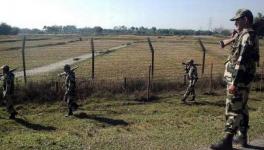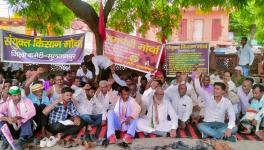Protecting the Land in the Northeast

Image Courtesy: Punch
The Inner Line Regulations, commonly referred to as the Inner Line Permit system (ILP), first gained legal effect through the Bengal Eastern Frontier Regulation, 1873. This law applied to the districts of Kamrup, Darrang, Nowgong (Naogaon), Sibsagar, Lakhimpur, Garo Hills, Khasi and Jaintia Hills, Naga Hills, and Cachar. The Regulation was further extended to the Eastern Dooars in Goalpara district, the Mokokchung subdivision in the Naga Hills, the Sadiya Frontier Tract, the Balipara Frontier Tract, and the Lakhimpur Frontier Tract along the then NEFA. The effect of this Regulation was to restrict the entry of persons who were non-native to the areas covered under it. The purpose of these Regulations has been contested at various points in time. Colonial administrative writers saw the regulations as a paternalistic protection towards the ‘backward’ people who lived in these areas, the ‘tribes’. Debojyoti Das through her paper in the EPW, Colonial Construction of a Frontier: Debating the Inner Line Regulation in Sibsagar-Naga Hills, has lucidly dispelled this common misconception. Her paper detailed the manner in which these regulations came into being with protecting colonial capitalist interests as their main objective.
The Foreigners (Protected Areas) Order, 1958 is the modern embodiment of the ILP. This Order was passed in furtherance of the Foreigners Act, 1946. The Order defined the ‘inner line’ throughout present-day India starting from Jammu and Kashmir and ending at Mizoram. This inner line is different from the one envisioned in the Bengal Frontier Regulations. This line represents the furthest point up to the international border where a foreigner can visit on the strength of a visa alone. Beyond this point the foreigner is required to obtain a pass or a permit, hence ILP. In the Northeast under this Order, the inner line runs along the southern boundary of Sikkim. In Arunachal Pradesh it follows the southern and western boundaries up to the trijunction between Arunachal Pradesh, Assam and Nagaland, from there it follows the western border of Nagaland up to the trijunction with Assam, Nagaland and Manipur with Dimapur Railway station being exempted. It follows the western boundary of Manipur till the trijunction with Assam, Manipur and Mizoram. In Mizoram, it follows the western boundary till the international border. This Order was later supplemented by the Foreigners (Restricted Areas) Order, 1963 which bars Chinese nationals from entering the restricted areas.
At present the Bengal Eastern Frontier Regulation, 1873 continues to apply, but only in present-day Arunachal Pradesh, Nagaland and Mizoram. It had been lifted in the whole of Assam, as well as the entirety of present-day Meghalaya. While the purpose of the Regulation was to protect the interests of the colonial capitalists, the ILP was regarded very differently by the people residing in these places. For one, the many local arguments in favour of the ILP are precisely those articulated by the British and Indian administrators, before and after Indian independence. The arguments being, of protecting the ‘tribes’ from exploitation by ‘outsiders’ as well as protecting their culture and language. However, these are flawed arguments.
Firstly, none of the three states are in any sense homogeneous entities. Arunachal Pradesh has a multitude of peoples who can be lumped quite conveniently into three main divisions, the western end consisting of those who speak Tibetan dialects, the central consisting of those who speak Tani languages, and the eastern who speak Tai related languages, with some ‘Nagas’. These divisions ironically fall within the provinces defined by the Chinese in their border claims. The Chinese term the Tibetan dialect speaking area as Monyul, the Tani speaking area as Loyul, and the Tai area as Tsayul, with no claim over the Naga inhabited area of Longding district. In the absence of any real commonalities among the three main language groups, Hindi has emerged as the lingua-franca of Arunachal Pradesh. Hence, the protection of language is a laughable proposition as languages that are not ‘working’ languages eventually die a natural death.
Nagaland too is as heterogeneous, Naga nationalism and Naga identity initially began with the Church. The Church did not discriminate between ‘tribes’ and sought to supplant the ‘tribal’ identity with a ‘Christian’ identity, in effect creating a Naga national consciousness among the tribes who differed immensely from one another in terms of systems of local governance and cultivation practices among others. To communicate with one another, a creole Assamese was developed as a lingua franca, this is now known as Nagamese. Nagamese has become the link language and is a working language, however, English, too, is emerging as a lingua franca in urban areas. So much for protecting the languages and customs.
Mizoram is another state where heterogenous peoples have come to accept a lingua franca, possibly to the detriment of the other languages. What is referred to as the ‘Mizo’ language, is actually the language of the most dominant group among the Mizo peoples, the Lushais. Mizoram was initially referred to as the Lushai Hills, though there were many other peoples other than Lushais living, there. Like in the case of the Nagas, Christianity united the many peoples. However, after the creation of the state, the Lushai language was aggressively promoted as the only Mizo language. This process has pushed many of the lesser spoken languages into oblivion, with the probable exception of the Bru and Chakma languages.
The next issue is on protecting the ‘tribes’ from being exploited by ‘outsiders’. It is hard to imagine a more hypocritical position. The ‘tribes’ have been subjected to hydro-electric projects from companies owned by ‘non-natives’ which have damaged the topography, as well as submerged fertile land, particularly in the Himalayan regions of Arunachal Pradesh which is also a geologically sensitive zone. The oil drilling in Nagaland by ONGC close to the Assam border which was unceremoniously abandoned, has polluted the soil and groundwater. In this scenario, how can one claim to be protecting the ‘tribals’ from ‘exploitation’?
Despite these shortcomings, the ILP is still a very attractive and emotive prospect. Demands for the implementation of ILP have surfaced in Assam, Meghalaya and Manipur. The view in these states being that the ILP would enable these states to regulate the entry of ‘outsiders’, but more importantly, restrict them from owning land. In these three states, the demand for ILP was first led in Meghalaya. Pressure groups sought to lobby the then Chief Minister Mukul Sangma to get the Union Government to implement the system in the state. However, the demand was never fulfilled, with the Union Government terming the demand as ‘unconstitutional’. The agitations in Manipur and Assam were similarly summarily dismissed.
In all three states, the ILP issue is raised about the ‘influx’ from outside. However, the ILP has been reduced to a mere formality. The tourism departments of the states in which it exists provide all the information required to apply for a permit. There are no fees to be paid, and only a proof of Indian citizenship is required to apply for a pass. Similarly, for persons who wish to reside in these states, resident permits can also be issued. ‘Outsiders’ can be included on the electoral rolls and enjoy all other rights, with only land ownership being a restriction. Sikkim too has a de facto ILP to the extent that a non-Sikkim Subject holder cannot own immovable property in Sikkim. There is no real restriction on entry, trade, or residence in any of these states. Therefore, the only protection that the ILP system accords a state or a community is that non-natives cannot own immovable property. However, this too can be subverted as the hydro-electric and mining operations are the standing testament.
Get the latest reports & analysis with people's perspective on Protests, movements & deep analytical videos, discussions of the current affairs in your Telegram app. Subscribe to NewsClick's Telegram channel & get Real-Time updates on stories, as they get published on our website.
























